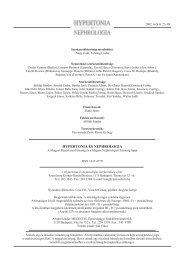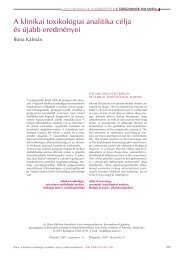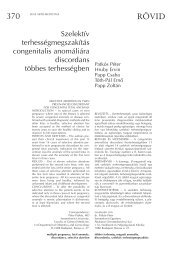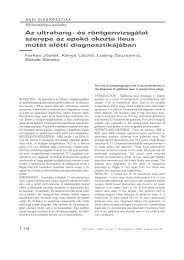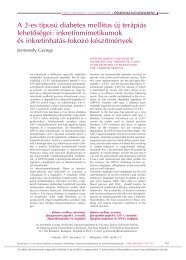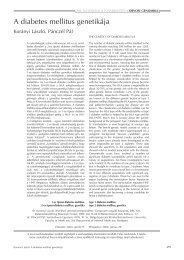HYPERTONIA ÉS NEPHROLOGIA - eLitMed.hu
HYPERTONIA ÉS NEPHROLOGIA - eLitMed.hu
HYPERTONIA ÉS NEPHROLOGIA - eLitMed.hu
Create successful ePaper yourself
Turn your PDF publications into a flip-book with our unique Google optimized e-Paper software.
ABBREVIATIONS<br />
CCD: cortical collecting duct<br />
ENaC: epithelial Na + channel<br />
Po : open probability<br />
ROMK: rat outer medullary K channel<br />
RT-PCR: reverse transcriptase-polymerase chain reaction<br />
SK channel: secretory K channel<br />
TALH: thick ascending limb of Henle’s loop<br />
TEA: tetraethylammonium<br />
ÖSSZEFOGLALÓ KÖZLEMÉNYEK<br />
Ontogeny of potassium transport in the distal<br />
nephron<br />
Lisa M. Satlin, M.D.<br />
Associate Professor<br />
Division of Nephrology Department of Pediatrics and Medicine, Mount Sinai School of Medicine, New York, N.Y., U.S.A.<br />
Correspondence<br />
Lisa M. Satlin, M.D. phone: (212) 241-7148<br />
Box 1664 fax: (212) 426-1972<br />
Mount Sinai School of Medicine e-mail: lisa.satlin@mssm.edu<br />
One Gustave L. Levy Place<br />
SUMMARY Kidneys of full-term newborn <strong>hu</strong>mans and animals conserve K + , a condition essential for somatic growth.<br />
The cortical collecting duct (CCD) within the distal nephron is uniquely adapted to retain total body K + early in life. CCDs<br />
isolated from newborn rabbits and microperfused in vitro show no net K + secretion until after the third week of life; in<br />
contrast, segments isolated from adult animals secrete net K + at high rates. The magnitude and direction of net K +<br />
transport in the CCD reflect the balance of opposing fluxes of K + secretion and K + absorption, mediated by principal and<br />
intercalated cells, respectively. Evidence now indicates that the limited capacity of the CCD for K + secretion early in life is<br />
due a limited capacity of principal cells for K + secretion, due, at least in part, to a relative paucity of conducting apical K +<br />
channels. A relative excess of K + absorption by intercalated cells may further reduce net urinary K + secretion. In fact,<br />
fluorescent functional assays identify significant activity of apical H-K-ATPase, a pump which reabsorbs K + in exchange<br />
for H, in neonatal intercalated cells. Under conditions prevailing in vivo, the balance of fluxes mediated by these two cell<br />
types likely contributes to the relative K + retention characteristic of the neonatal kidney.<br />
Key-words: potassium transport, neonatal kidney, distal nephron<br />
Supported in part by NIH grant DK38470 and a Grant-in-Aid<br />
from the American Heart Association.<br />
<strong>HYPERTONIA</strong> <strong>ÉS</strong> <strong>NEPHROLOGIA</strong> 2002; 6 (1):3–15.<br />
INTRODUCTION Total body K + content depends on the<br />
balance between intake and output, the latter regulated<br />
primarily by renal excretion. The kidneys of the healthy adult,<br />
whose homeostatic goal is to remain in zero balance, are<br />
responsible for the elimination of ~90% of the typical daily K +<br />
intake of ~1 mEq per kilogram body weight per day; the<br />
residual 10% of the daily K + load is lost through the stool (1).<br />
However, clearance studies reveal that newborns consistently<br />
demonstrate low baseline rates of urinary K + excretion, even<br />
when corrected for the low glomerular filtration rate<br />
prevailing early in life (2). The requirement of the growing<br />
subject for K + conservation is reflected in the observation that<br />
infants maintain a state of positive K + balance (2).<br />
Within the fully differentiated nephron, the final renal<br />
regulation of K + excretion occurs in the connecting and<br />
collecting ducts (1; 3-10). Cortical collecting ducts (CCDs)<br />
isolated from adult (8 weeks of age) rabbits and<br />
microperfused in vitro at physiologic flow rates secrete net K +



